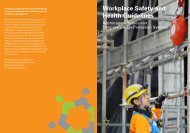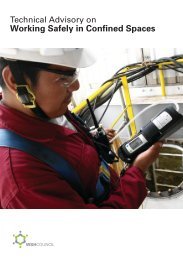Code of Practice - Workplace Safety and Health Council
Code of Practice - Workplace Safety and Health Council
Code of Practice - Workplace Safety and Health Council
Create successful ePaper yourself
Turn your PDF publications into a flip-book with our unique Google optimized e-Paper software.
2.2 Machine<br />
2.2.1 Sizing <strong>of</strong> the lifting equipment: One <strong>of</strong> the most critical factors in planning a lifting operation<br />
is to ensure that lifting equipment selected for the job has sufficient lifting capacity <strong>and</strong> reach to<br />
h<strong>and</strong>le the intended load. In the case <strong>of</strong> a tower, mobile, crawler or a lorry crane, the lifting capacity is<br />
dependent on the load radius <strong>of</strong> the crane boom <strong>and</strong> hence it is important in the selection <strong>of</strong> the crane,<br />
that the distance from the loads to the crane is known. This meant that the loading <strong>and</strong> uploading<br />
points within the worksite must be carefully considered relative to the location <strong>of</strong> the crane. For lifting<br />
operations involving multiple loads <strong>of</strong> varying shapes <strong>and</strong> sizes, the capacity <strong>of</strong> the crane should be<br />
selected based on the weight <strong>of</strong> the heaviest load so as to avoid any overloading.<br />
2.2.2. Maintenance <strong>of</strong> the lifting equipment: Another important aspect is the maintenance <strong>of</strong> the<br />
lifting equipment to ensure its structural integrity. Based on past incidents, attention needs to be<br />
focused on critical load bearing parts such as the following:<br />
• Wire ropes: There are many types <strong>of</strong> wire ropes for different usages <strong>and</strong> hence the<br />
correct type must be selected for the equipment. The wire ropes must be properly<br />
maintained (lubricated) to prevent the ropes from snapping during operation;<br />
• Braking mechanism: The ability <strong>of</strong> the lifting equipment to lift or suspend a load is<br />
dependent on the brakes connected to the hoisting mechanism. Any failure <strong>of</strong> the brakes<br />
would result in an unintended free-fall <strong>of</strong> the suspended load; <strong>and</strong><br />
• <strong>Safety</strong> devices: Most lifting equipments are equipped with a variety <strong>of</strong> safety devices such<br />
as limit switches or sensors. The safety devices will stop or prevent the lifting equipment<br />
from entering into an unsafe mode <strong>of</strong> operation, for example, an anti two-blocking device<br />
on a crawler crane serves to prevent the hook block assembly from coming into contact<br />
with the boom sheave assembly. It is therefore critical to ensure that such safety devices<br />
are functioning properly. They should never be by-passed during a normal operation.<br />
Further explanation is provided in Section 4 <strong>of</strong> this CP.<br />
2.3 Material<br />
There are a few key factors to consider in lifting a load. They are:<br />
2.3.1 Weight – This is perhaps the most important parameter that must be determined to prevent<br />
overloading <strong>of</strong> the lifting equipment. When the load is part <strong>of</strong> an assembled item, the weight <strong>of</strong> each<br />
component can be determined from the engineering drawings. Other times, one must rely on estimate<br />
based on density <strong>of</strong> the load that is being carried, such as concrete or rebars. Special attention is<br />
essential when the load comprises different materials such as in a rubbish bucket containing waste<br />
<strong>and</strong> debris. It is safer to be extra caution <strong>and</strong> estimate a heavier weight than to assume a lighter one.<br />
2.3.2 Centre <strong>of</strong> Gravity (CG) – During lifting operation it is critical to maintain the CG <strong>of</strong> the load<br />
directly beneath the load-line, i.e., hook. Otherwise, when the load is lifted, it will swing towards the CG<br />
Page 9 <strong>of</strong> 38

















